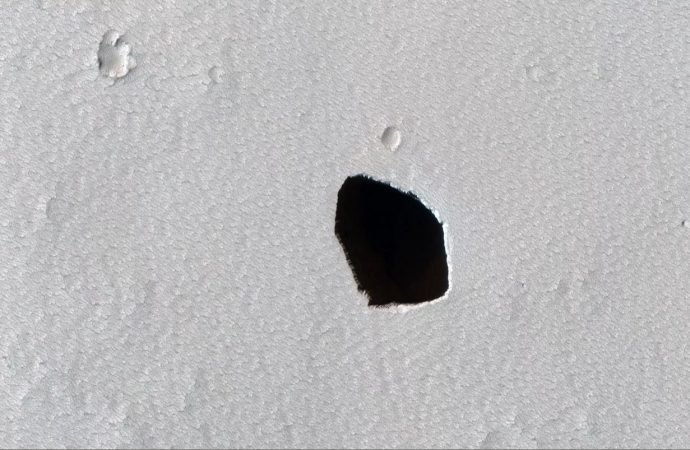Want to look inside a deep, dark pit on Mars? The scientists and engineers from the NASA’s HiRISE Camera on board the Mars Reconnaissance Orbiter have done just that.
Source: Universe Today
From its orbit about 260 km (160 miles) above the surface, HiRISE can this camera can spot something as small as a dinner table, about a meter in size. But look inside a cave-like feature on the Red Planet? Could this super-camera actually resolve any details inside this pit?

“Fortunately, HiRISE is sensitive enough to actually see things in this otherwise dark pit,” wrote MRO team member Ross Beyer on the HiRISE website. “Since HiRISE turned by almost 30 degrees to capture this image, we can see the rough eastern wall of the pit. The floor of the pit appears to be smooth sand and slopes down to the southeast.”
The hope in doing these special maneuvers to take this image, Beyer said, was to determine if this was an isolated pit, or if it was a skylight into a tunnel – similar to skylights in the lava tubes of Hawai’i.
No tunnels are seen in the visible walls, but scientists have ruled out that there could be tunnels in the walls that aren’t visible.
Dark pits on Mars are fascinating – probably because they provide mysteries and possibilities. Could anything be inside? Or this could be a place where humans could set up a base since it would provide shelter from Mars’ harsh environment. If a future rover mission were to land nearby, this pit might be worth a look – from a safe distance around the rim.
This pit is located in Tractus Fossae, a region of large ridges and troughs created by long-ago tectonic activity, near the Tharsis volcanic rise, a giant region on Mars that includes the three large volcanoes Ascraeus Mons, Pavonis Mons and Arsia Mons.
The HiRISE camera has provided incredible images of Mars since its arrival in Mars’ orbit in 2006. this camera can spot something as small as a dinner table. As its name implies, this high resolution camera is the largest ever flown on a planetary mission. HiRISE has allowed the orbiter to identify obstacles such as large rocks that could jeopardize the safety of landers and rovers, such as the Mars Science Laboratory Curiosity rover or the upcoming Mars 2020 rover mission.
Source: Universe Today

































Leave a Comment
You must be logged in to post a comment.